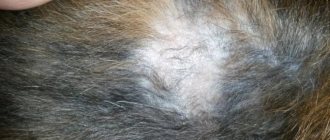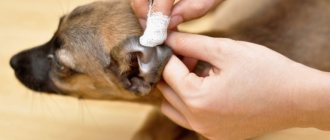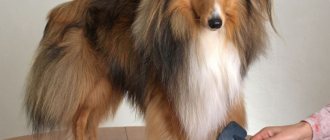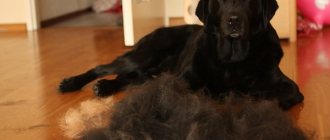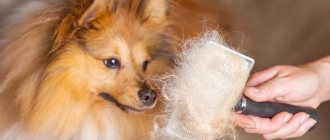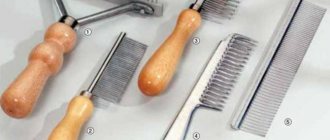Changing an old fur coat is considered a mandatory and natural occurrence in the life of a four-legged friend of any age, size and breed. Upon completion of molting, your pet's fur coat looks soft, shiny and silky. It is important for the owner to understand when the process is a natural necessity, and when it arises due to malfunctions in the animal’s body.
Why do dogs shed and how does it happen?
By appearance you can judge the physiological health of your four-legged friend. A soft, shiny, silky coat is evidence of the good functioning of the dog’s internal organs. But the hanging shreds cause a feeling of anxiety about his condition.
The natural shedding period in dogs begins in response to changes in external temperature and daylight hours. At this time, the pet produces an increased amount of the hormone melatonin, which is responsible for the thickness of the coat. The process of coat change is seasonal and lasts 2-3 weeks. During this time, the dog loses the old undercoat and guard hairs, in return growing new ones - more suitable for the current season.
Causes of severe hair loss in dogs
Possible causes of excessive shedding in a pet include the following:
- the presence of fleas and/or ticks on the body;
- various fungal or bacterial infections;
- allergy in an animal;
- side effects of medications;
- period of pregnancy and lactation;
- diseases of the kidneys, liver, thyroid gland and adrenal glands;
- sunburn, etc.
The reason for severe shedding in a dog can be the person himself if he bathes his pet too often.
During the period of shedding, due to internal imbalance and various diseases, the animal may begin to smell like a dog.
Also, the appearance of odor can be caused by improper or insufficient care of the animal.
Types of shedding in dogs
The period when a four-legged friend is actively getting rid of hair is not the most pleasant time in the life of the owner and his family members. Pieces of wool scattered throughout the apartment do not decorate the home. However, we must understand that this is a natural process that ends quickly. The types of shedding in dogs also depend on living conditions.
Seasonal
The fur protects the four-legged friend from environmental conditions: in winter - from cold, in summer - from overheating. To this you can add additional protection against infections and parasites. The coat change, respectively, occurs in spring and autumn.
Before the onset of cold weather, the animal gains a thick undercoat to protect it from low temperatures. The duration of the period is longer, and the result is a voluminous, fluffy fur coat. Spring replacement is much more active and noticeable, because the clumps fall out in large quantities. On average this lasts a couple of weeks.
Extracurricular
Four-legged friends living in a house or apartment are most susceptible to replacing their coats out of season. They are very sensitive to temperature changes and increased dryness in the living room. For example, extracurricular shedding in dogs begins when the central heating is turned on or off. Sometimes cases of hair loss can be associated with stress, as well as pregnancy and lactation.
Pathological
Uneven shedding of hairs, the appearance of bald areas on the body, redness and inflamed areas of the skin are signs of illness in a pet. You should contact a veterinary clinic for advice. The specialist will conduct an examination, find out how long the dog’s shedding has been going on, take the necessary tests and prescribe treatment that will stop the pathological shedding of hair. The cause may be hormonal disorders, disruptions in the gastrointestinal tract, viruses, fungus or allergies.
Age
A decrease in the production of the hormone melatonin has a bad effect on the appearance of an elderly dog. Irreversible changes occur in the structure, thickness and natural shine of hairs.
Chronic diseases leave their mark on older individuals. Vitamin complexes prescribed by a veterinarian after examining the patient will help cope with increased hair loss.
Shedding periods
Wool is the main indicator of a pet's good health. If a dog has a shiny, beautiful coat, it is probably healthy and happy. Typically, shedding begins at 6-7 months in males and 8-9 in females. During this period, you need to take your dog for walks more often, feed him tasty treats, and be prepared for frequent house cleaning. It is necessary to create good conditions for the animal, because during the first molt the animal can be excited and overly active.
Important! A puppy's skin is not yet so dense, so combs and products need to be selected with soft bristles.
Shedding in dogs is a natural process.
Wool protects four-legged friends from various infectious diseases, parasites and hypothermia. If the coat is beautiful and well-groomed, this indicates good nutrition, proper care and a sufficient amount of vitamins and microelements in the body. Dogs that may have health problems have fur that looks and feels hard and not shiny; the animal often sheds and its skin is reddened.
In this case, you should contact a veterinarian, who will tell you which vitamins to give during shedding, and which ones to use as an additive to the main diet. Periodically, the coat is renewed, thus getting rid of old hair. After molting, a warm undercoat grows, which helps in the winter cold. In spring, shedding, on the contrary, allows the skin to breathe, the wool does not float and is well ventilated.
For each breed there are certain standards for weight, nutrition, and the molting process. In small breeds, shedding can occur quickly and unnoticed. In large dogs, especially long-haired ones, shedding continues for some time, and the pet must be thoroughly combed daily. This forces owners to think about how to make the process quick and inexpensive.
How long does it take for a pet to shed?
Typically, there are two stages in renewing an animal's fur:
- spring period
- shedding in autumn.
Every dog owner should be prepared for the fact that 2 or more times a year his friend will shed a lot of hair, which is extremely difficult to deal with without special tools. Although shedding lasts from 1.5 to 3 weeks, a lot of wool will accumulate in an apartment or house. With proper care of the animal, this time will pass unnoticed. During the shedding period, you need to brush your dog regularly and thoroughly.
If we talk about constant molting, then this condition should be alarming. You should contact a veterinarian or a more experienced dog breeder. Very often, when shedding, the fur can roll down, and such tangles can cause discomfort. Unscheduled shedding of fur is evidenced by:
- about the dog’s poor health;
- problems with the gastrointestinal tract;
- skin diseases.
It is also important to consider the climate in which the dog grows. In hot countries, she can shed only once a year, without gaining a thick undercoat.
When and for how long does the coat change?
It is impossible to determine the exact date when dogs shed. Shedding is entirely dependent on environmental factors. If it warms up early outside, then the spring change of cover will begin earlier. A sharp and severe cold snap at the very beginning of autumn causes unscheduled preparations for winter. It is also necessary to take into account the characteristic features of representatives of different breeds, the conditions in which the dog is kept, its diet and activity.
Puppies' first molt
The first down replacement in babies begins at the age of 2-3 months. In German Shepherd and French Bulldog puppies, shedding occurs later, at 3-4 months.
Replacement with teenage wool for long-haired babies lasts quite a long time - on average up to 9-12 months. Short-haired babies acquire “adult” undercoat and guard hair by the age of one year.
Subsequent molts
When a dog sheds depends not only on the breed, but also on different living conditions. A four-legged friend who lives in a city apartment with a constant air temperature and a lot of artificial light can change his coat regardless of the time of year. In such circumstances, the process can last all year, but at the same time be weakly expressed.
Planned and unplanned molting
Scheduled shedding occurs only 2-3 times a year and is required for all dogs, regardless of whether the pet lives in an apartment or in an outdoor enclosure. In addition, planned molting in bitches occurs after estrus, as well as after childbirth. All this is referred to as natural processes. In males, during puberty, shedding can last longer than 3 weeks.
Unscheduled shedding in dogs most often occurs in animals that constantly live in an apartment and do not get enough walks on the street. Many pet dogs also forget about annual scheduled veterinary examinations, vaccinations and deworming. And worms can cause problems with the coat, and with severe helminthization, shedding can continue for a whole year. Affects unscheduled molting and climate. Very often, even in hot winter, a dog can begin to shed its fur.
Important! It should be remembered that during the molting period the dog is very sensitive and requires constant care and attention.
Molting necessarily occurs in spring and autumn. There are a lot of means to cope with such a problem. You just need to spend time brushing and grooming your dog. Also, do not forget about proper nutrition and trips to the veterinarian. With proper care, shedding in dogs will not cause you much trouble, and your four-legged friend will feel good.
Currently reading:
- 15 Dog Breeds That Don't Smell or Shed
- How to choose a Furminator for different dog breeds
- All the reasons for the appearance of dandruff on a dog's coat
- Thyroid dysfunction in dogs (hypothyroidism)
Features of shedding by breed
Different types of fur are characteristic of different animals. Their structure, density and length differ. Because of this, natural replacement occurs in different ways. Some people tend to shed a large number of clumps in a short period of time, for others everything happens slowly and for a long time.
In long-haired
Owners of long and medium fur coats need periodic combing, which prevents the appearance of tangles. In addition, long-haired representatives are washed using special shampoos with conditioner and masks.
Every owner knows what to do when shedding begins in long-haired dogs - he has already learned from his first experience. The difficulty in keeping dogs with such a fur coat lies in the need for constant cleaning during seasonal molting. Furry animals include collie, sheltie, spaniel, Pekingese, Afghan hound, different types of shepherd dogs, Siberian husky and some others.
Often such breeds shed in patches - even with careful grooming, bald patches are visible on the panties or sides. But molting, fortunately, does not last too long.
In shorthaired
Smooth species, such as Rottweiler, Toy Terrier, Dachshund, Chihuahua, Pug, Bulldog and others, shed for a fairly long period. Their fur falls out unnoticed, but it is very difficult to remove. Only a vacuum cleaner can help remove short hair from carpeting or upholstered furniture.
In wire-haired
Representatives of miniature schnauzers, middle schnauzers, giant schnauzers, fox terriers, Airedale terriers and Scottish terriers are the easiest to care for. In dogs with coarse guard hairs, the undercoat does not change much. Accordingly, severe hair loss does not occur. Four-legged pets should be trimmed as necessary to remove dead particles.
Breeds that don't shed
For people who are susceptible to allergic reactions, only certain types of pets are suitable as pets. These include the Maltese, several varieties of poodles, Yorkshire terrier, Welsh terrier, border terrier, Bedlington terrier, wheaten terrier, Basenji, Xoloitzcuintle and some others. These dogs practically do not shed their hair and do not emit specific odors characteristic of the rest.
How different dog breeds lose hair
This process does not occur in the same way for all pets - much depends on the predisposition of the breed and the type of fur of the animal.
A dog's coat consists of an outer and an inner layer, which performs insulating functions. Depending on the length of the coat and the density of the undercoat, natural shedding varies.
Due to the lack of dense undercoat, the long-haired Yorkie loses a little hair during this period. Likewise the short-haired dachshund, pug or basset hound.
In turn, a German shepherd, even with a short haircut, has a thick layer of insulation, the loss of which twice a year can really disturb the owners of the apartment.
Animal care
Loving owners should clearly understand what to do when a dog sheds heavily. This process causes discomfort not only for humans, but also for pets. To help your four-legged dog easily survive this period, you need to take seriously its diet, bathing, combing and other grooming procedures.
What tools and combs are needed
Devices for removing tangles and old fur from a pet are very diverse. Their choice depends on the type of coat of the dog and the nature of hair loss. Most often used:
- massage brush-mitten;
- slicker;
- a comb with sparse, curved teeth;
- furminator (brush with metal teeth);
- tangle cutter (for long-haired animals).
Before purchasing a suitable tool, it would be a good idea to consult with a pet store seller, a veterinarian, or an experienced owner of an animal of the same breed.
Combing algorithm and frequency
The most convenient method of removing dead hair is combing with special brushes or slickers. The latter are used if there are redness, wounds, or irritation on the body.
For proper combing, guide the brush strictly in the direction of hair growth, lightly pressing the tool. This should be done carefully so as not to cause pain.
The brush should go deep enough to pick up the old fur coat. The dogs are combed out gradually, with leisurely movements. The procedure is performed as needed, but during the shedding period for short-haired breeds it is 1 time per day, for long-haired breeds – 2 times a day.
Nutrition and vitamins
Nowadays, it will not be a problem to buy vitamins for dogs at any specialized pharmacy or pet store. Introducing them into food is useful not only during the season of changing processes, but also at normal times. Before purchasing, you should carefully study the composition, or even better, consult with a specialist. Drugs that improve hair growth include:
- Brewer's yeast;
- fish fat;
- vitamin B.
In order for the coat to be replaced quickly, it is necessary to provide the dog with the right food. Protein should predominate in the diet, which ensures shine, softness and strong hair structure. It is advisable to introduce high-quality meat products and offal into the diet, including raw ones.
Is bathing necessary?
To speed up the combing process, you can give your dog a bath. Here special pet shampoos with a high percentage of protein will come to the owner’s aid. After bathing, dead hairs will be better removed, as the process of pulling them out will be much easier. Frequent water treatments are not recommended at this time - some breeds do not need monthly bathing at all.
What causes excessive hair loss?
There are many reasons why a pet may constantly lose hair, since many external and internal factors can affect this process. Here are the most common ones:
- Unsuitable food. Nutrition determines the health of an animal's skin and coat. An unbalanced menu or food that is not suitable for age or condition. You should also not feed your pet food for a breed that it does not belong to.
- Immune disorders. Hypervitaminosis or lack of vitamins, weakened by disease or weakened immunity contributes to hair loss. Hypervitaminosis can be suspected if the dog eats both food and natural food at the same time, and additionally receives vitamin supplements. The diet should be the same, and supplements should be approved by a veterinarian. Due to vitamin deficiency, the dog often sheds hair after childbirth and during pregnancy.
- Fungal skin diseases. Infectious and fungal dermatological diseases do not always cause partial baldness of the affected areas. If your pet sheds a lot, but there are no nutritional issues or chronic diseases, then you should try washing it with an antifungal shampoo. This will help heal the skin and restore its balance, since usually such products additionally have a good caring effect.
- Hormonal disorders. Pathologies of the secretory glands can lead not just to severe shedding, but to complete loss of hair in the animal. Usually such diagnoses are made quite early if they are congenital. Maintenance drug therapy will give the dog an absolutely full life. Acquired hormonal diseases can overtake a four-legged friend at any age; they can also be successfully controlled with medication.
- Liver diseases. As a result of poisoning, allergies, infectious and other diseases, liver pathologies can develop. This organ is very sensitive and, despite the ability to regenerate, suffers from many things - care, nutrition, physical activity. Hair loss is also accompanied by diseases of the pancreas, so diagnosis by a veterinarian is required. Complex treatment includes both diet and medications, so independent selection is impossible.
- Allergy. Not only skin allergies, but also food allergies cause both itching and excessive shedding in dogs. At the same time, it is not necessary that areas of the skin will be more red or combed. The pet should be immediately switched to hypoallergenic food. Combing should be done very carefully so as not to irritate the skin. Dogs respond well to a single dose of Loratadine if the reaction is caused by atopic intolerance. Give it half a tablet or the whole one, depending on the size of the pet.
- Stress. All animals have different temperaments, and for some dogs, even the smallest things can cause extreme stress. From fear, nervous overstrain, and extreme fatigue, animals may experience so-called “hysterical” molting. Many owners observe this when taking their pet to the veterinarian - on the way, after stroking the pet, clumps of fur remain in their hands. This type of treatment does not require, you just need to calm the animal. However, if after suffering stress the shedding does not stop and the dog’s behavior clearly indicates mental problems, you need to contact a veterinarian. You may need sedatives.
When a dog sheds heavily in winter, it should worry the owner. It is not necessary that there are significant problems with the pet’s health, but it is worth starting with a review of nutrition and hygiene. It is also impossible to bathe an animal too often; this causes dry skin, irritation and thinning of the fur, and subsequently its loss.
Special grooming procedures
Properly selected vitamin and mineral complexes and nutritional supplements can reduce the duration and intensity of the seasonal process. If they do not have a noticeable effect, you should consult a veterinarian. He will tell you what to do when your dog sheds heavily. You can also use grooming services.
Express molt
Professionally performed combing is called express shedding. It is carried out by a master in a hairdressing salon for animals, that is, in a grooming salon.
Express shedding includes brushing with a furminator brush, bathing with shampoo and conditioner, and drying with a special hairdryer. The procedure makes it possible to remove up to 90% of dead hair, and the effect lasts up to 3 months.
Trimming
Removing dead hair by plucking is called trimming. This is a health and hygiene procedure carried out in the salon. Trimming is recommended for wire-haired breeds (listed above), which find it difficult to shed dead particles on their own. A salon procedure is performed on average once a quarter, which allows you to maintain a neat appearance for your pet.
Methods for brushing pets
Methods for removing hair from dogs depend on its type, as well as whether the animal has experienced seasonal shedding.
Pets with long hair should be brushed with a special comb daily, while short-haired pets can be brushed with a massage mitt a couple of times a week.
Thorough brushing, affecting not only the coat, but also the undercoat, should be carried out 1-2 times a week.
Why does a dog shed for a long time and heavily?
A pet's appearance is a reflection of its health status. Therefore, any abnormal or extraordinary shedding becomes a serious cause for concern and a visit to the veterinarian. The cause of the problem is:
- hormonal disbalance;
- the presence of skin or intestinal parasites;
- infectious diseases;
- skin diseases;
- disturbances in the gastrointestinal tract;
- improper feeding;
- food allergies.
Only a veterinarian can help find out the cause and save the four-legged from inconvenience. Examination of the patient, taking the necessary tests, and a detailed conversation with the owner will allow you to prescribe optimal treatment or give recommendations.
Sometimes seasonal molting is delayed due to living in an apartment with intense heating. In this case, you should walk your dog more often and for longer, and also ask the veterinarian to prescribe good dietary supplements and vitamins.


